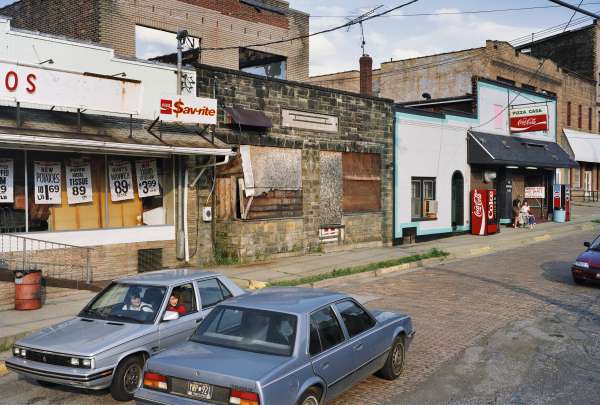
Perhaps the most influential study of photography to date, Roland Barthes’ Camera Lucida takes shape around an elision. A number of photos are reprinted in the text, but the one photo we don’t get to see is also the basis for Barthes’ philosophy: it’s a portrait of his late mother as a young girl. In the occluded image, Barthes recognizes “the truth of the face [he] had loved” and the essence of his own grief. Yet he decides that the picture cannot be reproduced because it is too private, too banal. “For you,” he writes, “it would be nothing but an indifferent picture, one of the thousand manifestations of the ‘ordinary.’”
Taken together, DuBois’ pictures raise a question: why are family pictures compelling if they’re not our own?
For the last thirty-five years, Doug DuBois has photographed the familial ordinary. “In Good Time,” his mid-career retrospective, opened this month at Aperture gallery. The show draws from three bodies of work: “All the days and nights,” featuring family pictures taken over twenty-five years; “Avella,” set in DuBois’ father’s hometown; and “My Last Day at Seventeen,” which explores coming of age in Cobh, Ireland. Taken together, DuBois’ pictures raise a question: why are family pictures compelling if they’re not our own?
“All the days and nights,” DuBois’ earliest series, chronicles the aftermath of his father’s fall from a commuter train in 1985. He spent a year in recovery, including four months in the hospital. DuBois’ mother was his primary caretaker during this time, and she “set up an infirmary in the living room.” Meanwhile, she suffered from depression and, in the coming years, made several attempts on her own life. The couple eventually divorced.
This is a timeline made available in the book’s afterward, but DuBois’ photos do more: they humanize this history and expose its paradoxes. To celebrate his mother, DuBois makes her more visible, not less. In one especially vivid portrait, she has a surgical wound on her neck, which is only partly covered by bandages. With sunken eyes, deep wrinkles, and pursed lips, she looks timeworn and ghostly—but, at the same time, powerful. She addresses the camera steadily, even shrewdly, and her pallor glows.
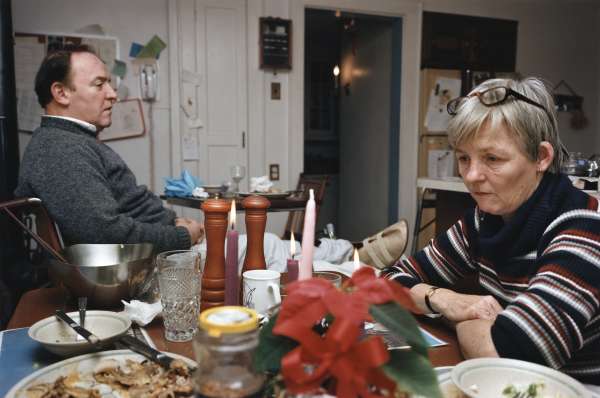
Susan Sontag calls photography “an aggressive act,” one that “violate[s]” people and turns them into “objects.” Since DuBois began making work about his family, he has fielded countless questions about his parents’ reactions and why he chooses to make their pain public. While “In Good Time” was being installed, DuBois and I spoke about some of these issues. He remembered feeling “empowered” by what memoirist Donald Atrim told his family: “‘I have a right to tell my story, and I’m sorry, but you’re in it.’”
Since the invention of photography in 1839, people have used cameras to preserve images of their loved ones. As Julia Hirsch describes, wealthy people could always afford to have their family members immortalized through painted portraits. But in the 19th century, cameras democratized the chance to cheat death: poor people could have their photos taken too.
Today, we take pictures for the same reasons we always have: to celebrate weddings and reunions; to remember first steps, first grade, first friends. Because children grow up too quickly and parents grow old too fast, we whip out our smart phones. We use Instagram.
From its conception, then, art photography has had to define itself against photography used for social functions, particularly within the family. One of the most popular and ambitious exhibits of its time, the Museum of Modern Art’s 1955 show, The Family of Man, sought to represent “the essential oneness of mankind” through images of families. The exhibit featured 503 photographs by 273 artists from 68 countries and drew a quarter of a million visitors to MoMA at its first showing. Its catalogue became a coffee table favorite in many American homes.
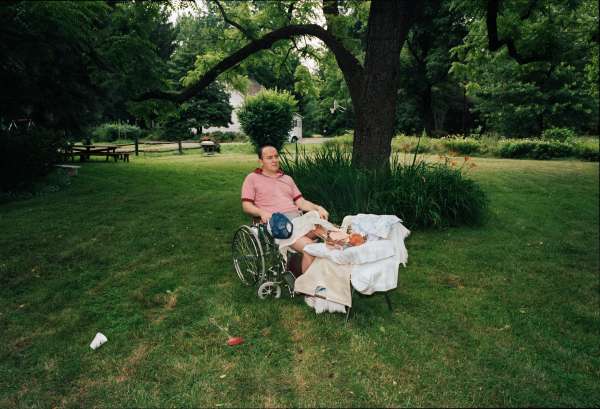
But the exhibition also provoked controversy, as Marianne Hirsch discusses. Curator Edward Steichen came under fire for stripping photos of their context and projecting the American nuclear family onto other cultures. In some ways, MoMA’s 1991 show, The Pleasures and Terrors of Domestic Comfort, was a repudiation of Steichen’s monolithic vision. Curated by Peter Galassi, this exhibition brought together work by sixty-three photographers—including DuBois—who made photos not from the “detached viewpoint of the journalist” but “from within” their home communities.
Many of these artists sought to complicate the ideology of the American family. In “The Kitchen Table Series,” Carrie Mae Weems combined self-portraiture and performance to expose the home as a site of gender-based conflict. Philip-Lorca DiCorcia and Gregory Crewdson staged haunting, cinematographic pictures of middle-class life, and Nan Goldin shot candid photos of her “found family” within the LGBT community.
Meanwhile, similar trends were afoot in the literary world. The 1990’s saw the rise of memoirs, including Mary Karr’s The Liars’ Club: A Memoir and Frank McCourt’s Pulitzer Prize-winning Angela’s Ashes: A Memoir. The genre’s growth was accompanied by an equal and opposite wave of criticism, indicting memoirists for their solipsism, self-pity, and phoniness.
For his part, DuBois thinks memoirs provide some of the same pleasures of long-term friendship. “When you say, ‘let’s get a drink and catch up,’ what do you do?” he asked me. I didn’t expect the question. “You’re weaving a memoir,” he said, smiling. “The drunker you get the further you go back.”
It’s tempting to think of photography, with its unique ability to “capture” reality, as somehow “more innocent, and therefore more accurate” than, say, a literary memoir. But, as Sontag writes, “photographers are always imposing standards on their subjects.” Every photo is a sum of judgments, an argument about how the visual world should be broken down and communicated.
DuBois said he began taking photos of his family “because they were the only ones with the patience to let me stumble.” Over time, he learned to direct his parents and started staging his pictures carefully. In his photographic memoirs, DuBois does not provide “proof” of his family’s past. Instead, he embraces subjectivity. “The last thing you seek in a memoir is a reliable narrator,” he told me.
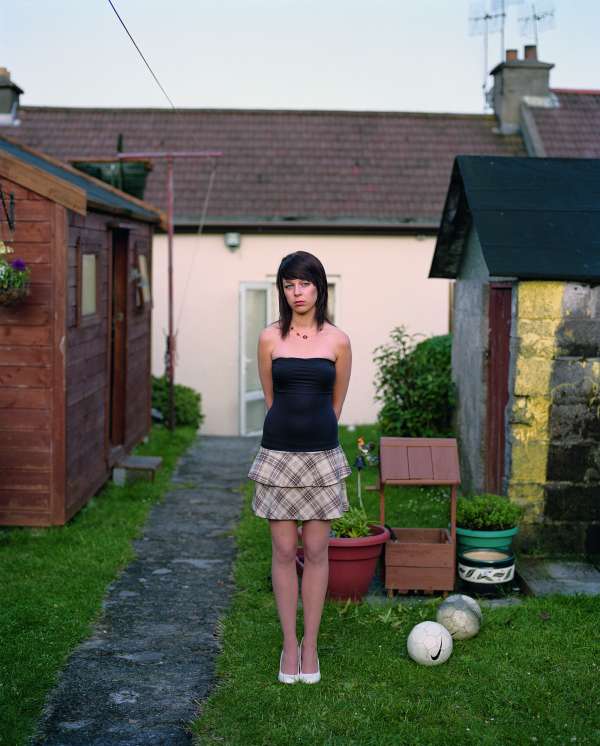
“In Good Time,” then, is partly about the limits of any one perspective. “All the days and nights” contains a 1985 picture of his parents staring past each other after dinner. His mother looks down at the table, and his father stares into space with his leg elevated. While sharing the same food and inhabiting the same kitchen, each person experiences the scene differently. They inhabit different planes. DuBois, of course, comes at the scene from a third angle. What we take as “head on” is only his point of view, and the series says more about his vision than what actually happened.
According to DuBois, American social life is fueled by “the myth that you will do better than your parents.”
Similarly, in “Avella,” we discover the Pennsylvania coal-mining town indirectly, through two subjective filters. To learn about where his family came from, DuBois drove his grandmother around in his aunt’s car, and she told him stories (sometimes he buried a tape recorder in a tissue box). One of my favorite pictures in the series bears witness to this process: taken from inside the car, the photo shows DuBois’ grandmother pointing out of the window, gesturing to her old house. Behind the fog and rain, the street is out of focus, but her hand isn’t. The finger curates: Look here.
DuBois’ access to Avella is familial, and he uses the family as a microcosm for the town. In one photo, a woman holds a boy who looks like her son outside a building labeled “Avella Lumber.” Hanging upside down, the boy looks joyful, but the cracks in the sidewalk are ominous. In another image, Main Street is nearly empty and shop windows are boarded up. Without anywhere else to be, people lean out of car windows to chat. According to DuBois, American social life is fueled by “the myth that you will do better than your parents.” His photos make us wonder how Avella’s families survive—and what economic uncertainty means for the ideology of The American Family overall.
In “My Last Day at Seventeen,” DuBois spent five years chronicling the lives of teenagers in the south of Ireland. He focused on Russell Heights, a neighborhood that, like Avella, was in the midst of “economic free fall.” This most recent series is especially powerful because we know where it comes from: even in a foreign context, DuBois’ motivations are personal rather than sociological, and he remains sensitive to the ways teenagers are formed by family life.
It’s fitting that DuBois focuses on adolescence, a time when parent-child ties are questioned and peer relationships assume new importance. In “My Last Day at Seventeen,” group photos resemble family portraits. In one portrait, four young men sport matching buzz cuts, football jerseys, jeans, and sneakers. They seem to have adopted each other as models, perhaps at the expense of their parents. Other photos—of little girls in wedding dresses and teens with babies—suggest the cyclical nature of family rites.
Through lip piercings and eye makeup, highlights and corner-of-the-eye glares, young people control the way they look and the photographs that stand for them.
At the same time, “My Last Day at Seventeen” also marks a departure from DuBois’ memoirist work. Most pictures in the series are set in the liminal spaces—the street corners, backyards, and secluded beaches—that teenagers claim as their own. Parents are rarely pictured, and the teenagers appear, on some level, homeless. They scale walls, skip between yards, and wander empty lots. One portrait of a young teenager—maybe thirteen or so—shows her posing outside her home in heels and a halter-top with soccer balls at her feet. She looks out of place, like she dressed for a future that may not exist.
At times, this limbo—between childhood and adulthood, between one home and the next—gives the teenagers a sense of freedom. The houses in Russell heights are painted pink, blue, and yellow, like the palette of a picture book. A child plays with his puppy; an adolescent practices flips with his friends. In one picture, a young teenager hangs from a 50-foot telephone pole overlooking the neighborhood (apparently he stayed there until a band of adults called him down). Close-ups of the teenagers’ faces also suggest their agency: through lip piercings and eye makeup, highlights and corner-of-the-eye glares, young people control the way they look and the photographs that stand for them.
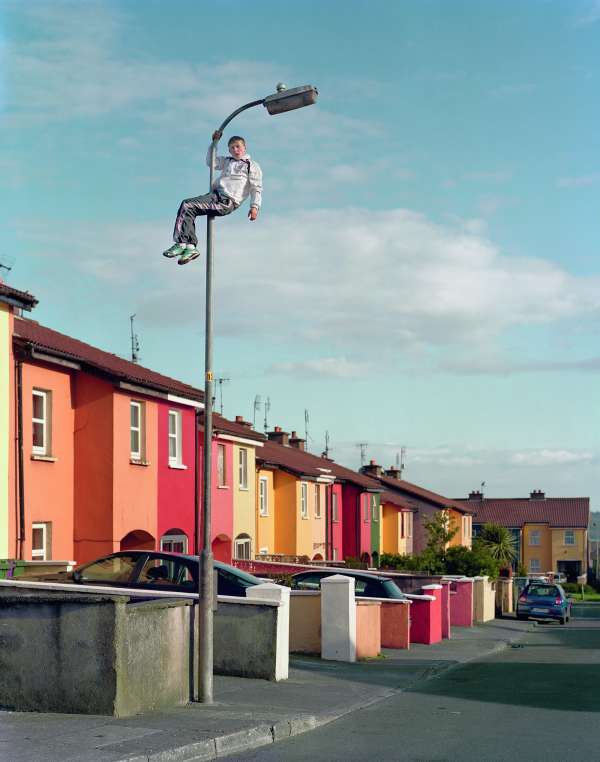
DuBois told me the aim of this series is two-fold. On the one hand, he wanted the photos to “speak to the community,” to “respect their lives,” and to express an “emotional truth.” On the other hand, the work needed to resonate with viewers who “know nothing” about Russell Heights and its residents. Dubois explained that this is a theme in his family work, too. His photos mean different things to different people, and he avoids privileging one audience over another. As he told me, it’s a question of parsing “what to say and, more importantly, what not to say.”
In DuBois’ view, his work does not offer “the immediacy of a journal” but the truth-value “of reflection.” Similarly, his retrospective makes clear is that it is possible—and perhaps most responsible—to regard DuBois’ artistic trajectory from multiple vantage points. This approach to understanding the trajectory of an artist or the history of a family is only possible “in good time.” To be part of his story, I realize, is an honor.
